It’s been a trend as of late with some of the larger brands that have been around for a while to bring back a classic model from their archives. Whether as a special edition or as a retro mainstay of their line, these reissues stand out amongst modern watches, often surpassing them in style. Tissot continues this trend with a complex watch that is a dazzling today as it must have been when it was first released; the Heritage Navigator 160th Anniversary.
The story of the Tissot Heritage Navigator 160 starts in 1953 with Tissot’s 100th anniversary. The 1950’s marked the dawn of commercial air travel. It was trendy, sexy and luxurious, so it is of no surprise that watch brands began designing for the jet-set. Famously, you have watches like the Rolex GMT-Master, with its iconic “Pepsi” blue and red bezel as well as GMT function for tracking multiple time zones. For their centenary Tissot created a very innovative World Time watch, which could be used to tell the time, at a glance, for major cities around the world, as well as jump forward time zones with the press of a button. With commercial and business travel becoming more widely available, one can see how the World Time watch took the GMT concept to next level.
For their 160th anniversary, Tissot recreated it as a modern watch. They kept much of what made the original design interesting and charming, but increased the size dramatically from 36mm to 43mm, and used modern components through out. The design of the watch mixes function and style, with a busy, but elegant dial that was as unique in the 50’s as it is now, in fact, it’s perhaps more now. The watch still functions the same way, giving you accurate time worldwide at a glance, but now features a Chronometer grade ETA 2893-3 movement, which replaces a GMT hand with the world time disk. As such, the pusher at 2 that would advance the disk is gone, and instead one uses the crown.
Fine vintage examples of the World Timer from the 1950’s easily go for 4k, which isn’t bad for what it is. World Timer’s are uncommon to begin with, and ones from that era are especially rare. The new Heritage Navigator in steel will cost $1,650 and be available this fall, which while not inexpensive, is much less than the original and a good price for a COSC certified ETA 2893. And what you will find with the watch, apart from function, is that it really is unlike other watches you’ve seen or worn. It has a very distinct personality that is fun, elegant and a touch luxurious.
 Case: St Steel
Case: St Steel
Movement: ETA 2893-3 COSC
Dial: Silver/White
Lume: yes
Lens: Sapphire
Strap: Leather
Water Res.: 30M
Dimensions: 43 x 51mm
Thickness: 10 mm
Lug Width: 22 mm
Crown: 5.5 x 2 mm
Warranty: Yes
Price: $1,650
Case
The biggest, pun intended, difference between the original World Timer and the recreated Navigator is the sheer size of it. The difference between a 36mm watch and a 43mm watch is like the difference between a Smart car and an Escalade… they are worlds apart. And while this seems as though it is in response to general trends towards larger watches (which thankfully seems to be waning a bit) I believe the size increase was functional too. This is a very busy watch, and even at 43mm you can find yourself a bit overwhelmed by information. At 36mm, I imagine you would have needed a magnifying glass to read the inner disk.
So, the stainless steel case measures 43 x 51 x 10mm, which includes the gently domed sapphire crystal. The width of the case is tempered by its thinness, which prevents it from feeling or looking bulky in anyway. The watch is actually very flat, and plate like, which emphasize the all-business topside. The design is also very simple and faithful to that of the original watch, with a wide bezel and fat straight lugs as the main formal attractions. The crown at three is also fairly small, measuring 5.5 x 2mm, which keeps it in scale with the height of the case.
The case also has very simple finishing, with polished surfaces on the topside of the lugs and bezel, and vertical brushing on the side. The watch has an “all-dial” feeling despite having a wide bezel, as the non-rotating bezel is a functional part of the dial. As such, the lack of fancy finishing or case geometry is actually to the watch’s benefit. Anything ornate would create more visual interference, making the watch too busy for its own good. That being said, what is there is well done, every edge is very crisp and the polish is nice and bright.
The display case back is a bit more decorated, with an elegant scrip font and some filigrees inscribed around the aperture. The large sapphire window gives a great view of the 2893-3 movement inside, which is minimally decorated. The most standout visual element of the 2893-3 is the large golden rotor, which is decorated with Cotes De Genève and a bit of text. Oddly, this is the only place on the watch that indicates that it is a chronometer, or has been certified by COSC.
Dial
The dial of the Navigator displays a lot of information at one time, doing so in various levels. It’s actually a very clever design that utilizes every little bit of dial real estate to indicate something. It also really stays true to the original. As I had mentioned before, the dial really starts with the bezel, which contains your typical 12-hour index consisting of numerals for the even hours and triangles for the odd. The markers are all etched into the polished steel dial, and filled in black for contrast.
Stepping in, and down, you have a brushed silver ring with a 24-hour index of applied steel markers. Once again, the even hours are indicated with numerals and the odd with small triangles. The 12th hour is missing, however, to create a gap for a vintage Tissot logo. At the very edge of this ring are small black printed lines for the minutes. This is one of the little tricky things to read on the watch, as the minutes index has 60 markers, and the 24-hour index doesn’t divide evenly into that, so you end up having to ignore one index to read the other.
Aside for that, this is a particularly attractive element. The brushed silver surface contrasts with the polished steel markers and bezel adding a textural element as well interesting play with light. The applied markers feel very much of the 50’s, like they are off the dash of a Cadillac El Dorado. They are functional, decorative and enjoyable to look at. Another nice detail here is the use of tritium dots (not sure if it is actually tritium, though the dial does say “T-Swiss Made-T”, which would suggest yes) on the outer edge of the ring; two dots at 24, and one at 6, 12 and 18. Tritium dots are just very cool, immediately giving the watch a vintage feel. In the dark, they aren’t the brightest things on earth, especially since they are so small, but they nevertheless give a touch of legibility at night.
Moving in to the center of the dial, you have the 24-time zone disk, or the Universal hour indicator disk in their terms. As the name describes, this index consists of 25 names of capitals around the world (Bombay and Calcutta are represented) as well as an International Date Line indicator. The disk itself is matte white, while the city names are all in dark blue and the IDL is in red. The mix of red white and blue is very nice and once again plays off of the silver ring around it for a bit of contrast.
There is a lot to read on this disk, and the text is very small, but with a bit of concentration one can make it out. One thing that is very interesting about this disk, is that while it is perceived as part of the dial, it is constantly in motion. As such, it’s always changing through out the day. Though the changes are subtle, it does make for a more dynamic watch.
In order to read this inner dial, you simply choose a city and read it against the 24-hour index around it. Assuming the time is correct as per your location, the time around the world can be read. The local time or home time is then read on the primary hands of the watch, via the external bezel and the minute index on the periphery of the inner dial. It can be tricky at first to read the local/home time as it is uncommon to look to the bezel for your 12-hour index. You get used to it, and if you can’t help but read the 24-hour index, you can just halve the hour.
The hour and minute hands are blue steel and dauphine style with thin lines of lume. The blue of the hands works nicely to accentuate the blue text on the 24-time zone disk, and also really pops against the silver ring. Dauphine style hands were a nice choice. They appear to be faithful to some versions of the original, have an aire of class, and yet are bold enough to be legible. The seconds hand is then a thin silver stick, which more or less disappears against the dial.
Movement: ETA 2893-3
The ETA 2893-3 appears to be a slight variation on the more common 2893-2 GMT caliber, with a disk in place of the GMT hand. It’s still a 21-jewel automatic with hand winding, hacking seconds, 46 hour power reserve and a frequency of 28,800 bph. Besides the time zone disk, what makes this movement special, is that the one featured in the Heritage Navigator is COSC (Contrôle official Suisse des Chronomètres) certified and therefore can be called a chronometer.
What that is actually a bit complicated (here is a great article on Gear Patrol for reference), but in the end what it means, history aside, is that the movement has been tested and regulated to achieve -4/+6 second accuracy over a 24-hour period. In other words, it’s highly accurate and will keep precise time. COSC movements do come at a premium though, and it is entirely possible for non-COSC movement to be as accurate, but this has gone through the testing and has been certified as such.
There are different ways you can think about using this watch. It can be a traveler’s watch, or an active 24 time zone/world time watch. You set the watch by setting your home time on the hands, and setting the time zone disk correctly. If you then hopped on a plane and crossed a time zone, the watch would be off. So, you then have 2 options. You could move the local time forward/backward to be correct, and then recalibrate the disk to the correct world time. Or, you could leave the hands at your home time, and read the local time off of the time zone disk. I personally would find that difficult. Some other World Time watches allow you to jump the hour hand forward by the push of a button, which feels more logical.
The other way to use it is to forget about the traveling aspect and just use as a quick, live, indicator of time around the world. This is a great tool for people who conduct business in countries around the world, have family overseas, etc. When using the watch in this manner, you just set it once to your local time and time zone and everything else should fall into place.
Strap and Wearability
The Heritage Navigator has 22mm lugs and comes mounted to a medium/dark brown leather strap with a gator texture. The strap tapers from 22 – 20 at the clasp, giving it a thinner appearance than most 22mm straps. It’s a nice strap of good quality that works very well with the palette of the watch. Altogether you have silver/steel of varying finish, white, blue, red and brown, which create a very handsome mix.
Perhaps my favorite detail of the strap is actually the deployment clasp. It has a very interesting design that allows for the long side of the strap to go under the short side, preventing the need for keepers. This creates a streamlined appearance that works with the overall aesthetic of the watch. The clasp itself has an interesting shape, with large buttons on either side and a sizable vintage Tissot logo etched in. Overall, it’s a good strap that looks right on the watch, though for the price I did expect a genuine gator.
On a table and in photos the watch is beautiful, but on the wrist it really comes to life. The watch simply doesn’t look or feel like other watches. The dial, hands and bezel glisten wildly as you move it around in the light. It’s a bit flashy, but in a way that speaks to the aesthetics of the 50’s. The large size verges on being too big, especially lug-to-lug, but the watch has such a distinct personality that it just works as a large watch. That being said, I don’t know how well it will fit wrists under 7″.
The styling of the watch is also very handsome and unlike anything else out there. It’s retro, but doesn’t feel irrelevant to today’s style. It has dressy elements, but there is something fun and adventurous about it giving it a sport quality. All in all, it’s just very versatile, looking great with business and casual attire. It’s also surprisingly comfortable for a large watch. The 10mm height makes it svelte, keeping it hugged to your wrist so you never feel like it will bump into something.
Conclusion
The Tissot Heritage Navigator 160th Anniversary is one of the more interesting watches we’ve had the chance to review. The look of the watch, as an enlarged 50’s era vintage, is really unlike anything else out there and the world time function is unique, intriguing and practical if you need it. Given its looks and functionality, it’s attracts some attention and its history makes it a bit of a conversation piece. There aren’t many world timers out there, very few that date back to the 50’s, and none, to my knowledge, are in this price range. At $1,650 for the steel models in white or black this is not cheap, but for a chronometer grade movement and world time function, it seems like a fair price. Between the looks and functionality, the Heritage Navigator falls squarely into that accessible luxury range, and seems worth saving for.
by Zach Weiss
Review sample lent by Tissot / Swatch Group US









 Featured Videos
Featured Videos





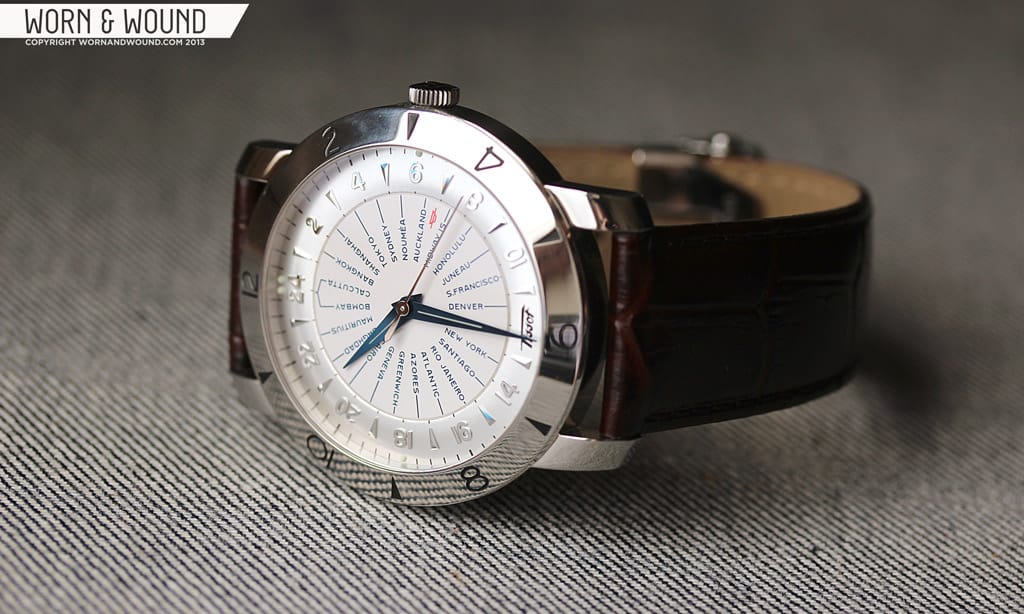

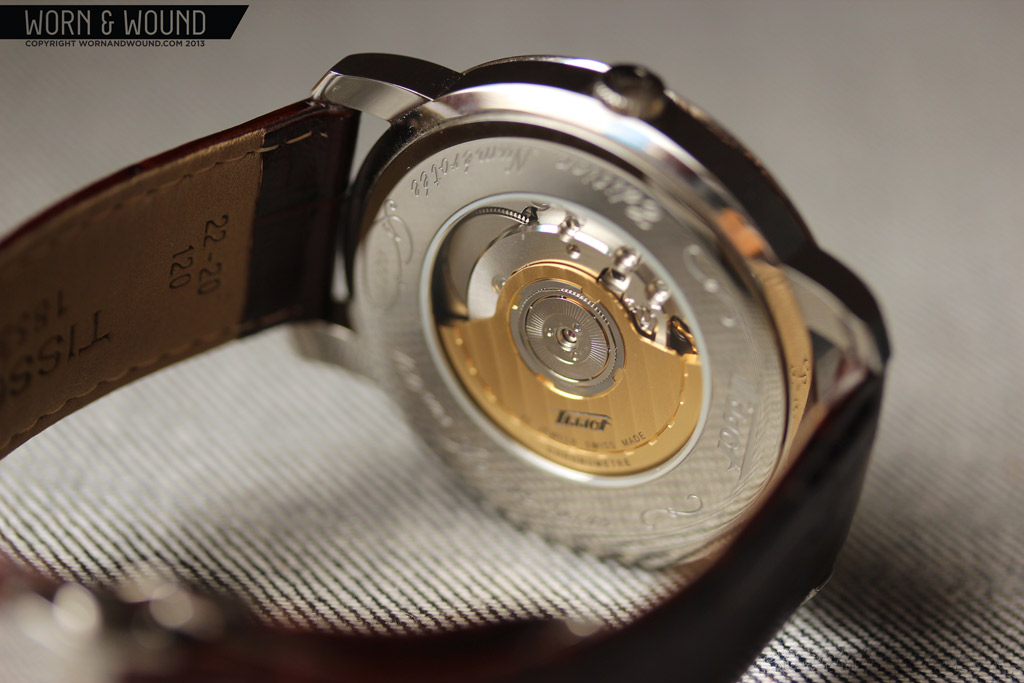
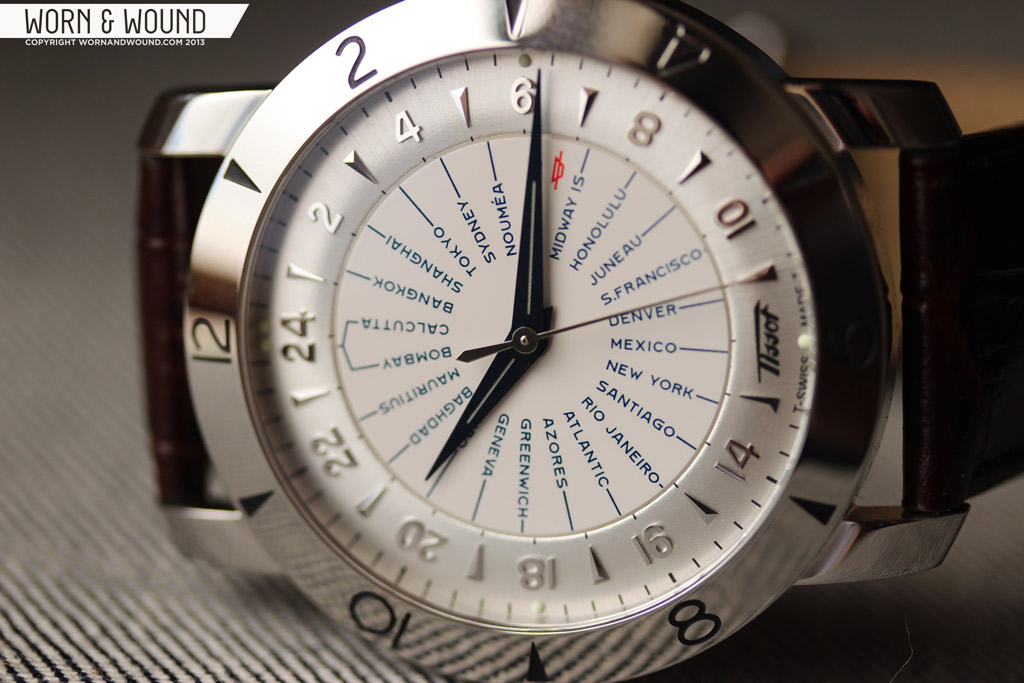
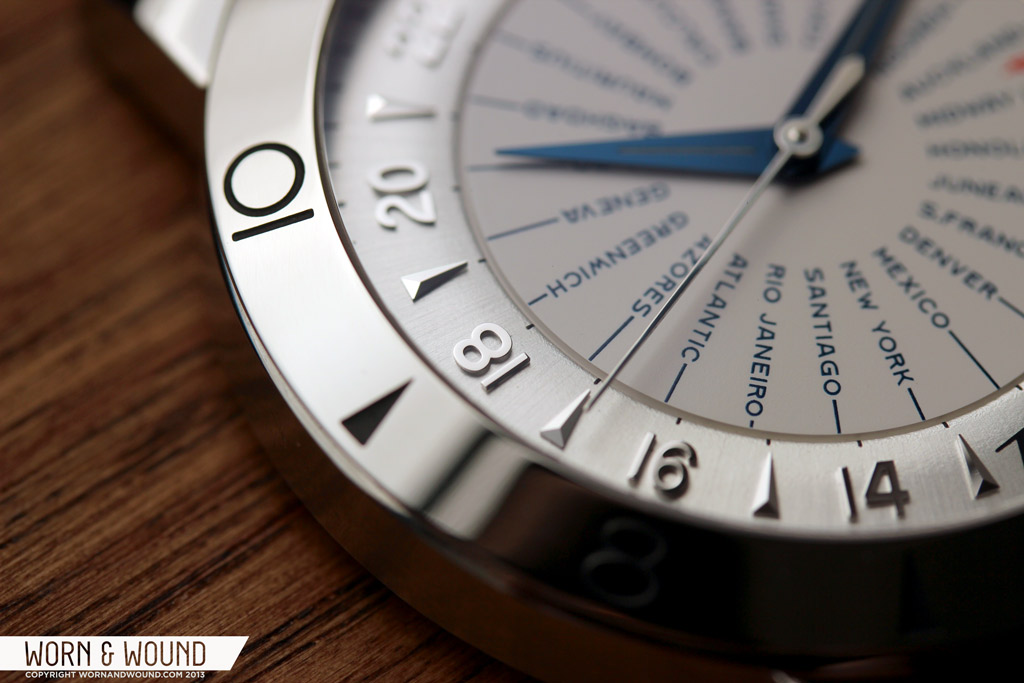
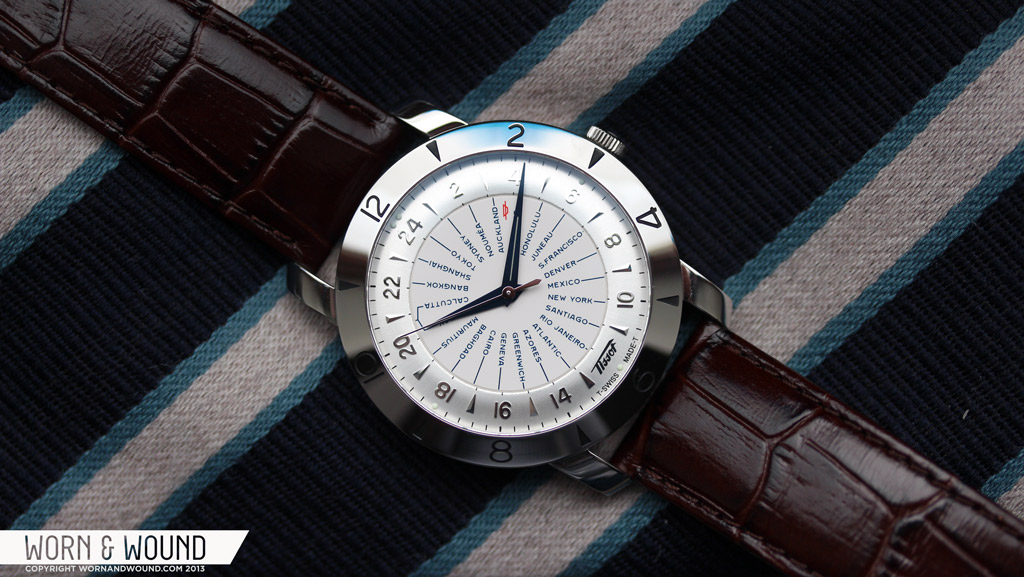
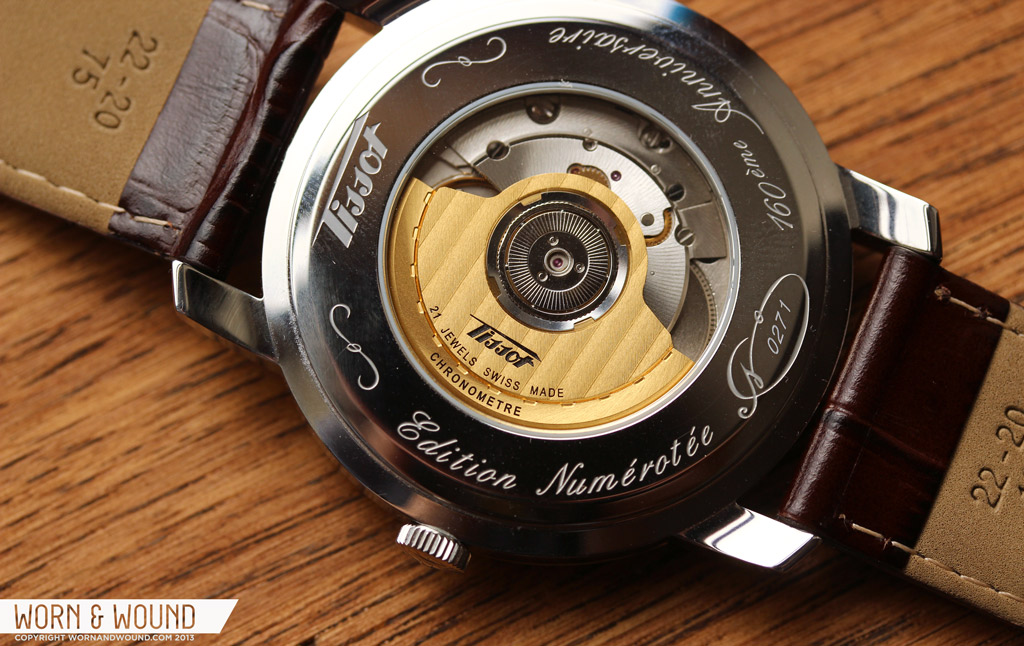

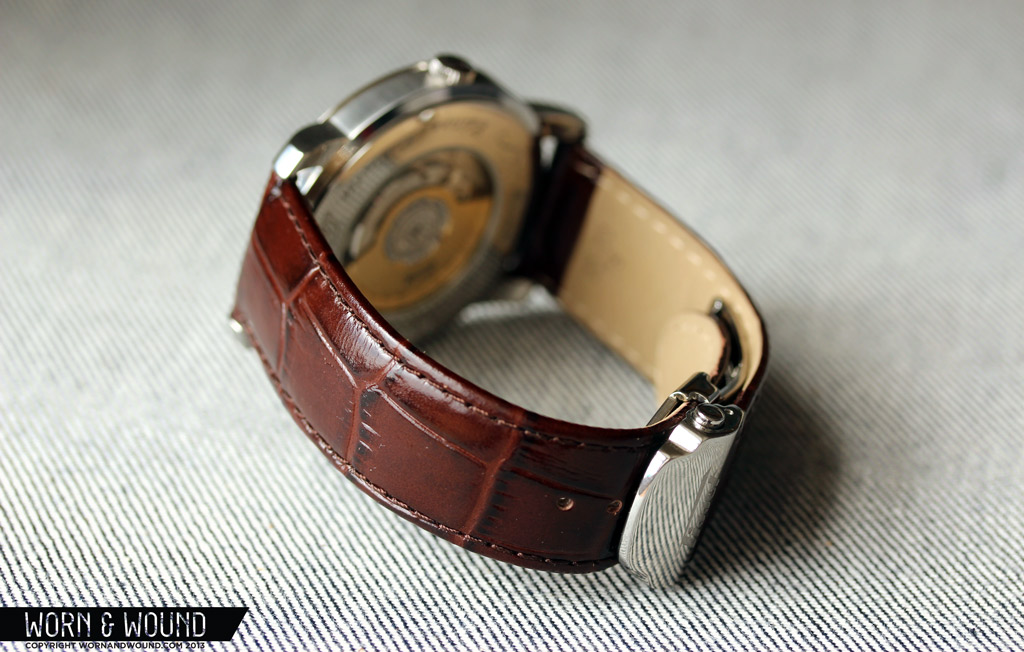
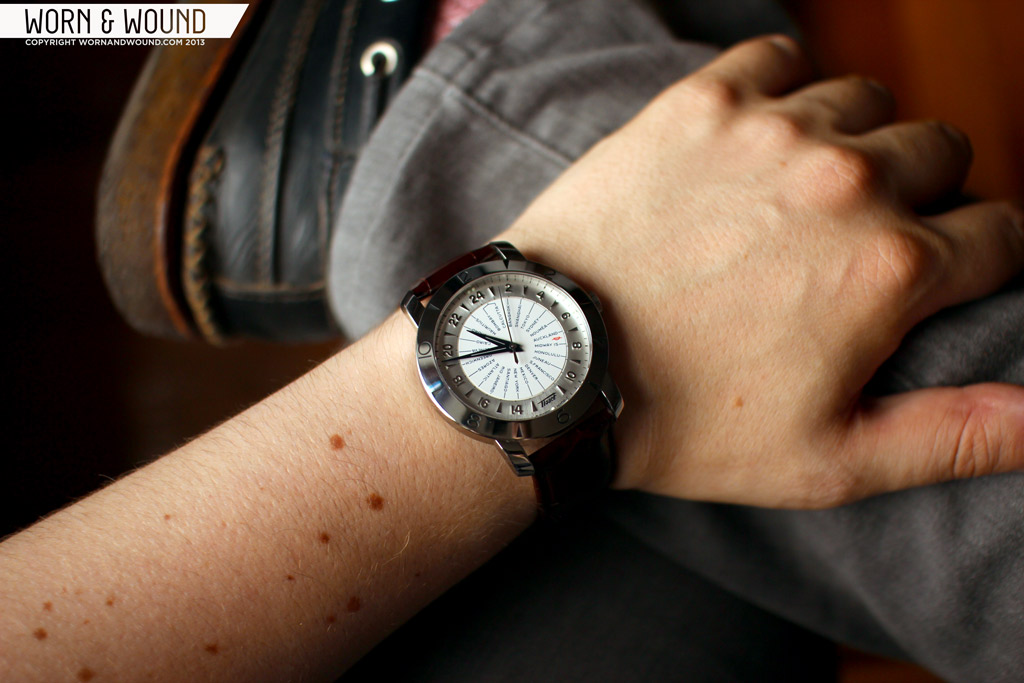
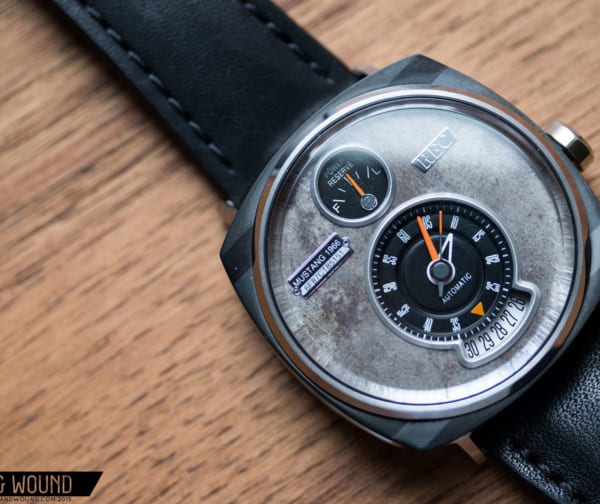
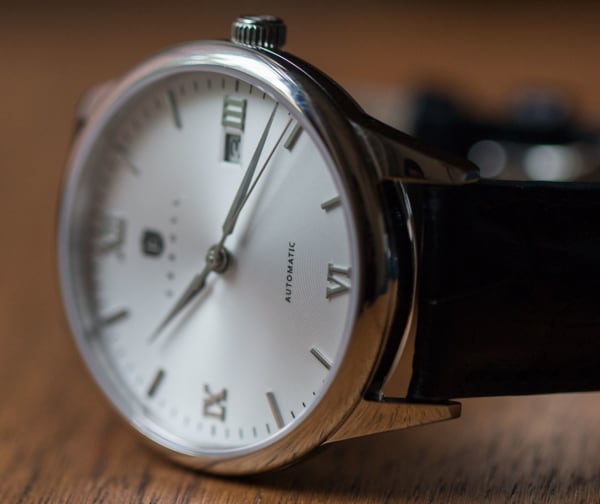

Tissot seems to have a wealth of great designs to pull from their heritage. I really like the somewhat retro selection of cities and names (Bombay). I would love to try this beaut on! Great review
Wow this is a great watch and a great review as always, i have always loved Tissot watches would love to get my hands on this piece too bad its way out my price range currently.
It’s probably just me, and I would like to like this watch but something seems off.
Perhaps the exterior 12 hour bezel is just too wide and polished – narrower with smaller numbers would be more elegant – without numbers possibly best. This would have allowed for a slightly more classic (read smaller) size as well.
The flat slab side of the case could use more detailing as well.
I do like the city names radiating out from the centre, but perhaps a small bevel in the centre would complete the city “disk”. The middle of the watch just seems to float to me.
Love the buckle though!
I’ve had a Tissot Visodate Heritage model for about three years and I gotta hand it to Tissot when it comes to reinterpreting models from their archives. This Navigator model is another beauty, although the 43mm diameter is larger than I would prefer. Still, it’s a hard watch to fault.
This heritage watch looks nice, but in reality a piece of garbage. I bought one in November 2013, but from the beginning it was bad. First it was extremely fast (30sec/day). So I took it back to regulate. They told me in the official service that it was put together as shit. They corrected it and they said it is ok now. This was not true. Actually since the beginning the second bezel (time zone disk) was not synchronized wth the main time and was not possible to adjust it. In addition it started to be late( 20-25 sec/day). I took it back, they said that they cannot be repaired on the spot, but it has to be sent to the central service to Switzerland. It will take 6 weeks. This is terrible from tissot no quality control and sell garbage for more than 1000€. Do not buy it!
Would you care to sell the watch to me? I would love to own this watch at a more affordable price than for a new one, along with the defects.
Thanks for the very nice review. Has anyone seen the version with the black dial? The Tissot marketing photos show it having a deep jet black color, but Google images have many photos where it’s actually more metallic and light gray looking. Very different looks.
Nice review. I’ve owned this for a while and still enjoy it. I’m not wild about the strap, though it’s nice enough. I prefer something a little more matte finished. Finding replacement straps is hard unless you want to put up with a notch in the strap where the buckle tang would normally go. Finally, I wish it was about 41mm instead of 43mm. It wears large with the bezel, though it’s nice and thin for it’s size.
Overall, a cool piece that I enjoy wearing. I feel intercontinental when I wear it.